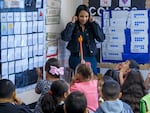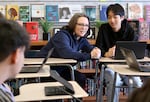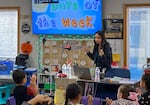Yoshira Escamilla was student-teaching at McNary Heights Elementary School in Umatilla when she was asked to take over a kindergarten classroom in the middle of the school year.
That was January 2021, and Escamilla has been teaching ever since. Now she’s leading a new class of kindergarteners, next door to Ann Johnson — the same longtime kindergarten teacher she learned from as a 5-year-old.
“It’s really awesome,” Escamilla said. “I go down there if I ever have questions, she helps me out a lot too, and so does the whole team.”
When Johnson was moving rooms recently, she found an old photo of Escamilla in kindergarten and shared it with her new colleague.
Escamilla has fond memories of her time at McNary Heights as a student. She remembers her teachers, field trips, and in second grade, taking recycling paper home to play teacher with her brother.
“I’d have him sit down and work on something, and then I’d grade it,” she said.

Yoshira Escamilla teaches her kindergarten class at McNary Heights Elementary School in Umatilla, Ore. on October 4, 2022. Escamilla attended the school and graduated from Umatilla before coming back as a teacher in 2021.
Elizabeth Miller / OPB
As a high school senior, she wanted to go to college but wasn’t sure she could afford it without scholarships or other financial help. She started to renew her interest in teaching by working in the afterschool program at her old elementary school.
“I would go to the afterschool program [as a child] and it was always arts and crafts, and I love arts and crafts,” Escamilla said.
After graduating in 2016, she went to Blue Mountain Community College, got her associate’s degree and learned about scholarships. From there, she went to Eastern Oregon University, joining the Oregon Teacher Pathways program, an EOU Grow-Your-Own effort. She graduated debt-free and now she has a full-time job.
“Next thing you know, I was a teacher!”
Escamilla teaches in the school’s dual language program. As someone who is bilingual and bicultural, she wanted to connect with students who started school as she did.
“I started kindergarten only speaking Spanish,” Escamilla said. She remembers her first-grade teacher at the time, who spoke Spanish with her.
“Having a teacher who could understand me and would speak back to me in my first language, it was real, really nice,” Escamilla said. “I felt like she could understand me. I didn’t feel like I was struggling.”

A photo of Yoshira Escamilla as a child. Escamilla attended McNary Heights Elementary School in Umatilla, Ore. Now she teaches there.
Courtesy of Yoshira Escamilla
School leaders are trying to capitalize on the interest of young people like Escamilla as part of a systematic effort to expand who teaches in the state’s classrooms. In some Oregon districts, teacher recruiting efforts start early – often when future teachers are still in high school. Programs to grow-your-own teachers have the potential to stave off staffing shortages. They also allow schools to diversify the workforce and better reflect the students they serve – while also building strong connections to the community.
Now as a teacher, Escamilla said she hopes her students feel connected in the classroom and free to speak with her in English or Spanish – whatever language they feel most comfortable with.
“I remember me, being a student, sometimes you hold back in asking questions because you don’t know how to ask the question because of the language barrier,” Escamilla said. “I feel like because I speak Spanish, they’re able to ask me anything because I’ll understand them.”
She said her experience working in the afterschool program showed her she could be a teacher, something that wasn’t on her mind before.
“I feel like there’s a lot of students, like young students, like high schoolers who might not know that teaching is something they want to do,” Escamilla said.
Across the state, in a classroom in Portland, there’s a group of high school students getting to explore those options, too.
High school students get a taste of teaching before graduation
In a classroom at David Douglas High School, students sit in a circle of desks, debriefing each other and teacher Michelle Wood on their experiences as classroom interns across the district.
They’re talking about a classroom management strategy known as “proximity” – when a teacher stands close to a student as a way to tamp down student misbehavior.
“I think there’s definitely ways to do it, and you’ve all seen teachers that do the opposite of that from across the room, being like, ‘Aubrey, put your phone away!’ … that does not have the same effect,” Wood said.
“That just makes you uncomfortable,” a student replied.
Students and teacher Michelle Wood start talking about the other ways teachers try to get students to stop talking and pay attention, and how it can sometimes feel like teachers use power to make students feel bad.
“As someone who wants to be a teacher, I don’t get it either, what reaction do you want from the students?” said senior Liana Kucher.

David Douglas High School students (left to right) Liana Kucher, Mel Borbon Tabarez, and Kenai Robertson discuss their experiences working in classrooms across the district as part of an Intro to Education class at the school. Some of the juniors and seniors in this class want to become teachers and the class offers an opportunity to try it out before they even graduate high school.
Elizabeth Miller / OPB
This is Intro to Education, a dual credit class hosted at David Douglas High School where students also receive college credit from Mount Hood Community College.
Over the course of the year, students essentially get two courses in one: in the first semester, students learn everything from different teaching strategies and student personalities to education funding and curriculum standards.
“And then they’re taking that learning and applying it to their experiences in the classroom the second semester,” Wood said.
Most of the 12 students in the class are interning in elementary schools across the district. Senior Aubree Najera is in a kindergarten class.
“I think kindergarteners bring energy back to me,” Najera said. “They’re just so fun and lively, and also the teachers, I was able to say what I needed and what I wanted, I was like, ‘Can I get a class list of everyone’s names and a seating chart’?”
The rest are getting their introduction to teaching in high school classrooms, like Kenai Robertson, who wants to teach high school English. He said his time interning in a sophomore English class has taught him a few things he couldn’t learn sitting in a class.
“You have to make these intuition calls,” Robertson said, using seating charts as an example. “That’s something that you just learn over time, trial and error. You can’t just plan it out, you have to just feel it out.”
Another David Douglas High School student and aspiring teacher, Dora Hussein, says she learned about multitasking.
“With this class, you kind of really understand what teachers go through when 10 students are raising their hands at the same time,” Hussein said.
Students discuss what they see working in a classroom and what helps students feel comfortable.
But through their internships, students are learning as much about things to do as a teacher as things not to do. Nine of the students say they want to be a teacher or they’re “teacher-curious.”
Others are realizing teaching might not be for them.
“When I first thought about it, I wanted to become… a dentist, doctors, nurses, but I decided to choose this career as a backup career,” said junior Kevin Le. But as Le has spent more time in a 4th-grade classroom, he’s gotten more excited about teaching as a possible first-choice career.
Jennifer Gonzalez, whose internship took her to a first-grade class, said she’s thinking that teaching is not her plan. But sometimes she’s not sure, especially when she considers the connection that teachers can make with students.
“The other day, as soon as I got to the class, this student that I help a lot, she came to me and she gave me a flower and a hug, and that made me really happy,” Gonzalez said.
Students are also learning about interpersonal relationships by working with teachers.

David Douglas High School teacher Michelle Wood, left, demonstrates “proximity,” a strategy to manage student behavior, with junior Kevin Le on April 5, 2023. Wood teaches an Intro to Education class that is part college course, part classroom internship for students who are interested in becoming teachers.
Elizabeth Miller / OPB
“I realize that I wanna become a teacher for the students and not for myself basically if that makes sense,” Hussein said. “And just because I wasn’t clicking with the teacher, I was 110% clicking with the students. And I feel like that’s what makes me, like eyes open. I was like, ‘Yeah, I wanna become a teacher’.”
Wood also sees benefits for the district in who is taking her class and considering a career in education.
“The diversity of the students that take this class is definitely representative of our student population,” Wood said. “And so I think that is definitely beneficial to our future staff.”
Jesus Ruiz Alcaraz, one of Wood’s students, says he was inspired by a cultural event at Ron Russell Middle School. A counselor there said schools need “more teachers who are Hispanic males” — like him. After that, Ruiz Alcaraz talked to a friend who, when they got to the U.S. from Mexico, didn’t feel comfortable at first because she didn’t see a teacher who looked or talked like her.
That sealed it for him.
“That was more a step towards like yeah, I want to be a teacher because I want to help all types of kids, kids that are coming from a different place, and with different languages, because that’s how my brother was too, and my parents,” Ruiz Alcaraz said.
Other students in Wood’s class agree.
‘Grow your own’ programs common statewide, but teacher diversity remains low
In a September 2022 report, the Oregon Educator Advancement Council, a statewide group, made their findings clear.
“While the numbers of racially and ethnically diverse students and teachers continue to increase, the rate at which the student population is growing is consistently the same or a higher rate than in the teacher population, meaning the demographic gap is not being closed,” the EAC shared.
Statewide, they report that 12.9% of teachers are ethnically and linguistically diverse, compared to 42% of students. David Douglas has a similar proportion of teachers of color, but a student body that’s even more diverse — 68% students of color.
In Umatilla, the gap is a little smaller, with 23% teachers of color compared to an enrollment that’s 75% non-white.
Oregon has financially supported Grow Your Own programs as a way to diversify and grow teaching ranks across the state, as part of a $30 million investment for programs to recruit and retain diverse educators. According to the Oregon Educator Advancement Council, the state is supporting 27 Grow Your Own programs, with funds from the Student Success Act.

Yoshira Escamilla’s kindergarten class at McNary Heights Elementary School in Umatilla is part of the school’s dual language program, where students learn both English and Spanish. Escamilla attended the school as a child.
Elizabeth Miller / OPB
The programs rely on collaborations with local community colleges and universities while also keeping the prospective teachers engaged in the districts they grew up in. David Douglas has received state funding and is working with Portland Community College, Pacific University, Portland State University and Warner Pacific University, as well as online programs in other states.
Michelle Wood’s Intro to Education class is only one component of the program the district is running to diversify its teaching ranks. It also assists current David Douglas employees in moving from support roles in classrooms to teaching positions.
Eastern Oregon University is involved in Grow Your Own programs, through agreements with several local school districts, including Umatilla.
“Those partnerships, those connections really make a big difference not only because they help us hire students who are familiar with our community and who understand our region, but also students who are bilingual, bicultural, which is really important in our system,” said Heidi Sipe, the district superintendent in Umatilla, where 22% of households in the county speak languages other than English.
Umatilla has a particular staffing challenge: Its dual language program requires teachers who are fluent in both Spanish and English. The Grow Your Own program is one way to get those teachers.
It’s not just about having bilingual and bicultural students, though. Sipe said there’s an added interest in having students who grew up in Umatilla come back to teach at Umatilla.

Yoshira Escamilla has been teaching at the school she attended as a child since 2021. This year, she’s teaching kindergarten.
Elizabeth Miller / OPB
La’Shawanta Spears is director of Diversity and Equitable Inclusion at the David Douglas School District — the home to Oregon’s largest high school and one of the most racially and ethnically diverse student bodies. Spears runs the district’s Grow Your Own program.
She’s heard that students want teachers who look like them. As an African American woman, when she worked as a counselor and school administrator, she felt she connected with students of color, particularly Black students, in a different way.
“They would say, ‘You’re like my mom, Ms. Spears, you act just like my mom or my sister or my auntie,” she said. “[...] they related to me a little different because I looked familiar because I sounded familiar.”
Those connections are an important part of building relationships and trust between teachers and students.
“I am not saying that every teacher needs to be a teacher of color, but we definitely need to find some balance in it,” Spears said.
Research has shown that all students tend to benefit from having diverse teachers — not just students of color.
Spears said the students in Wood’s class also have a summer internship opportunity to work as instructional assistants in the district.
Feeling ‘like home’ for students, while solving school staffing challenges
Back in the David Douglas High School class, students say they want to come back to teach because they feel comfortable in the school and community they grew up in.
“This district, in general, is kind of like home a little bit, because we spent our whole lives here, and you kind of get comfortable with this district, and this school,” said senior Aubree Najera.
Beyond their community, senior Mel Borbon Tabarez wants to support students like her. She came from another district, not knowing English well.
“I feel like by me coming back, it’s like a thank you […] because I got so much help, I got so involved in this school,” she said.
“And I would just love to be that teacher that encourages students to get involved, to make connections, I want my classroom to feel like home.”
Spears in David Douglas said the goal is not not just recruiting and hiring teachers of color but retaining them.
To help support staff of color in the district, David Douglas hosts monthly activities and offers professional development opportunities.

Umatilla teacher Yoshira Escamilla leads her kindergarten class in singing the days of the week. Escamilla teaches at the same school she attended as a child, in the school district she graduated from in 2016.
Elizabeth Miller / OPB
But in both Umatilla and David Douglas, sometimes growing your own teachers doesn’t result in them staying with the district.
In Umatilla, teachers have access to mentorship for three years. But sometimes, Sipe said, those teachers don’t get their contracts renewed.
“If they haven’t grown into a stellar teacher, we’re not going to renew them and so we have a number of teachers that make it here, just three years doesn’t mean that they’re not a good teachers, it just might mean that they’re not going to be a good teacher for Umatilla kids,” Sipe said.
With the most recent class of Grow Your Own graduates in David Douglas, Spears said they ran into a different problem: they wanted to hire everyone, but two educators got picked up by another district before David Douglas administrators could offer them a job.
“Two were swept away by other districts before we could even get a letter of intent,” Spears said. “Lesson learned on my end.”
